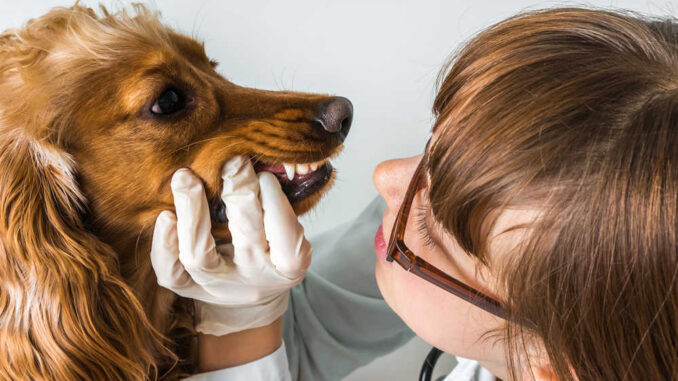
This article was updated on February 9th, 2024

Oftentimes, owners don’t even know their pet has an oral lump and we discover it during a routine health check. This is not surprising, given that most dogs dislike having their mouths examined too closely. In this article, we will review the most common bumps and lumps found inside a dog’s mouth.
Lumps often found inside a dog’s mouth
If you notice a growth inside the mouth, you should consult with your vet right away. There are a number of possible causes. Continuing on with our list, let’s take a closer look at each:
1. Epulis
The most common benign (non-cancerous) growth found inside a dog’s mouth is the epulis. We tend to see these fleshy pink or red growths in snub-nosed dogs, including Boxers and Frenchies who are middle-aged.

Though they start off small, they can grow quite large, even covering teeth, as shown on the picture below.
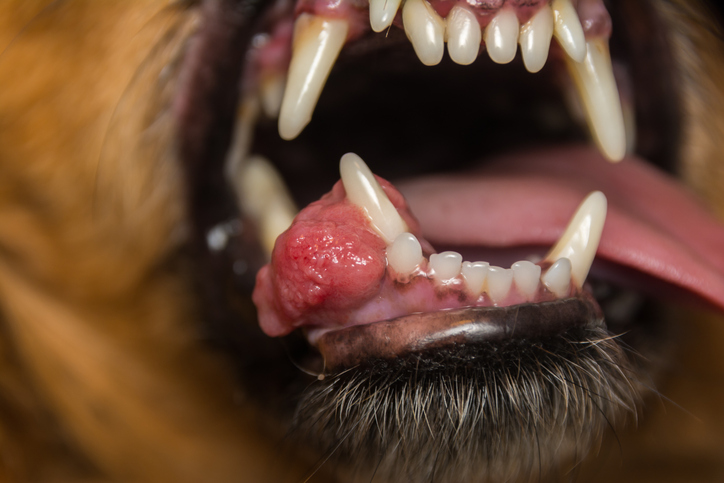
In addition to the lump, owners may notice that their dog is drooling more, has bad breath, and is leaving drops of blood behind on their toys and chews. Your vet can biopsy these growths to confirm diagnosis. Treatment will generally include surgical removal. Many owners combine the surgical removal of epulis with dental cleaning.
Read more about Epulis or Gum Growths in Dogs.
2. Papillomas (warts)
Papillomas can equally appear inside the dog’s mouth, not just outside it. Some dogs will develop quite a few of these masses and they will be both inside and outside of their mouths, as shown in the pictures below:
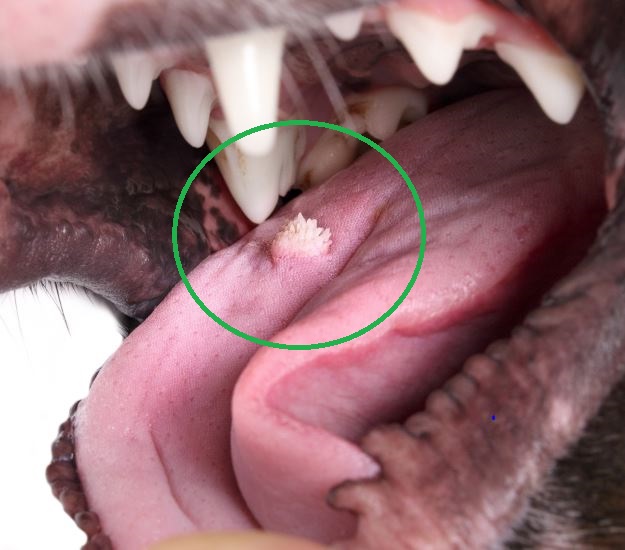
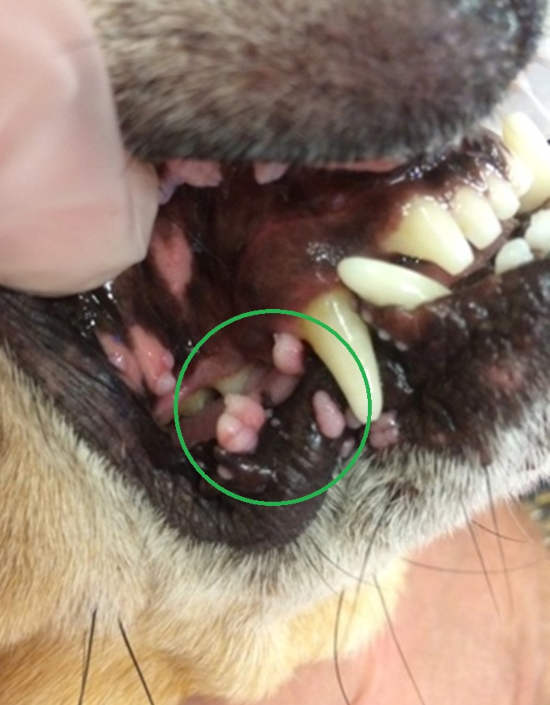
Oral warts tend to remain small and look like little cauliflowers. Additional symptoms are uncommon, but some owners might notice bad breath. If the lesions are rubbed against, they can start to bleed for a short while. Read more about Warts: Pictures, Diagnosis, Treatments.
3. Oral melanomas
The most common malignant mouth lump is a melanoma. Sadly, these growths tend to act very aggressively. While they may look quite small, it is not uncommon for them to have grown deeply underneath the visible surface at the time of detection. They can cause teeth to move and even fall out and are associated with bad breath, swelling, and oral infections.
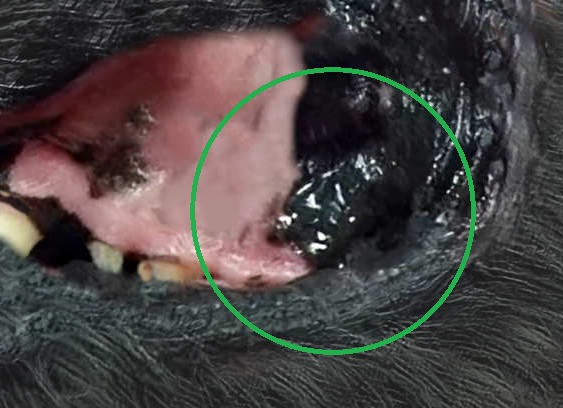
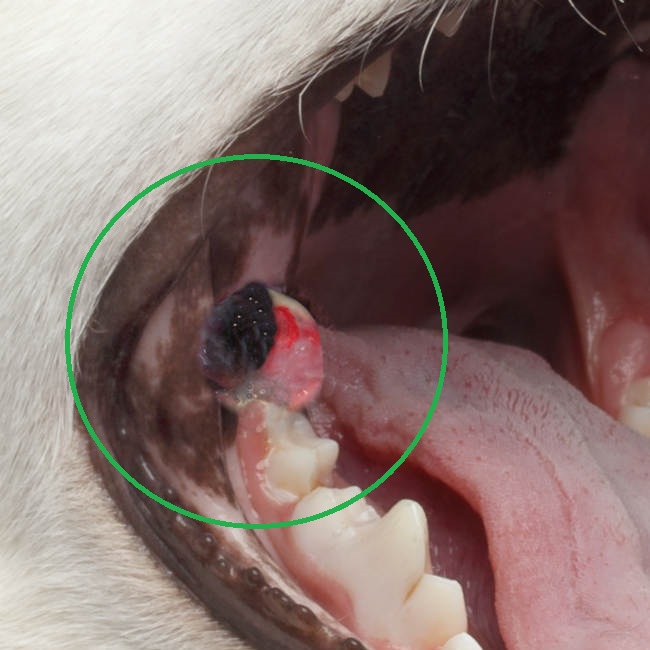
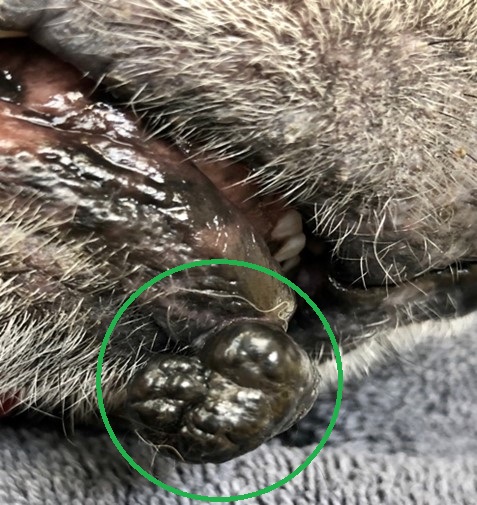
As is seen in the pictures above, these growths will appear quite irregular, may bleed, and usually contain some darker, black pigment. To diagnose an oral melanoma, your vet will biopsy the growth and often perform staging to see if the cancer has spread. The mass and any locally affected lymph nodes should be removed, and radiotherapy will be an option for some individuals. Learn more about Melanomas (Pictures, Treatments, Prognosis).
4. SCC (squamous cell carcinoma)
An SCC is the next most common malignant growth we see in our canine companions, and they will usually appear on the gums and/or tonsils. This is another aggressive cancer type and often leads to ulceration and local bone destruction. You can view a picture here (On Today’s Veterinary Practice).
As well as sampling the tissue, your vet should perform some imaging to determine the extent and spread of the cancer. The treatment will usually consist of surgical removal (where possible) and/or chemotherapy and radiotherapy. You can see pictures and more information on this page (On Veterinary-Practice.com).
5. Dental abscess
In some cases, oral masses can be due to localized dental disease and infections. When bacteria and pus proliferate, a painful abscess can form under the gum. This tends to come on quickly and may be associated with visible swelling of the cheek. In older dogs, dental abscesses are seen quite commonly, especially when they’ve never had a dental.
The most common signs of a tooth root abscess in a dog include facial swelling and pain when opening the mouth. We’d also expect to find advanced dental disease and halitosis (bad breath) within the mouth. These dogs can be quite uncomfortable and may refuse food or have trouble eating.
The treatment is surgical removal of the infected tooth, pus drainage, and the provision of antibiotics and anti-inflammatories. View Pictures of Tooth Abscesses.
A new mouth lump or bump is something that needs to be taken seriously.
This is because these growths could potentially be sinister, and the prognosis is better the sooner treatment is started. Factors that would be of concern when it comes to oral growths include:
- A lump or bump that is growing and changing rapidly
- Masses that are firmly attached to the tissue underneath
- Lumps that ulcerate on the surface and that become infected
- Any lump associated with other signs, such as trouble eating or bloody drool
- A lesion inside the mouth that has dark pigment
Veterinarian diagnosis and treatment
Diagnosis for mouth lumps and bumps
More straightforward benign lesions like pustules and papillomas can be recognized by experienced vets without any particular tests being performed. However, if the vet has any doubts or the lesions aren’t resolving, the growth should be sampled. This may mean a fine needle aspirate (FNA) or biopsy. The cells taken from the lesion will be sent to the lab for analysis.
When a mouth lesion is found to be malignant (cancerous), your vet may perform staging, whereby they check for signs of spread around the body by sampling local lymph nodes and performing diagnostic imaging studies.
Diagnosis will cost about $60 (exam) to $150-400 (FNA/biopsy)
If your vet is able to determine that you are dealing with a non-sinister lesion in your dog’s mouth, the cost will simply be for the consultation, about $60-100. They will advise you to keep a close eye on things to ensure the lesions resolve.
If sampling is needed, there will be both lab fees and procedure fees. This will usually be about $150-200 for a FNA or $250-400 for a biopsy, in addition to the exam fee. If staging is needed, the cost will be much higher as this can involve CT scans and lymph node aspirates. We could be looking at a bill over $2,000 here.
Treatments
Treatment will depend on what we are dealing with. For pustules and infections, washes and antibiotics are the treatment of choice. For something like a wart (papilloma), most dogs don’t need specific therapy.
For malignant tumors, quick action is crucial because early treatment can significantly improve the outcome
When a dog has oral cancer, we want treatment to start promptly. Quick action is crucial when a new tumor is found inside a dog’s mouth because early detection and treatment can significantly improve outcomes and prevent the tumor from becoming more aggressive or spreading. The veterinary intervention will include surgical removal of the mouth mass, and possibly chemotherapy and/or radiotherapy.
Oftentimes, a specialist like an oncologist and/or surgeon will need to be involved. In this case, the bill can reach several thousand dollars.
Category 2: Lumps frequently found around the mouth and lips (not inside the mouth)
1. Canine acne
If you see red bumps around your dog’s mouth, especially if they are young or middle-aged, you may be dealing with canine acne. Certain breeds, including the Pug, Bulldog, and Boxer, are most predisposed.
You’ll see relatively small scabs and pustules, but no lesions inside the mouth. The skin is commonly red and may be swollen and itchy. These dogs often have other skin issues, such as itchy paws and pink skin on their belly and chin.
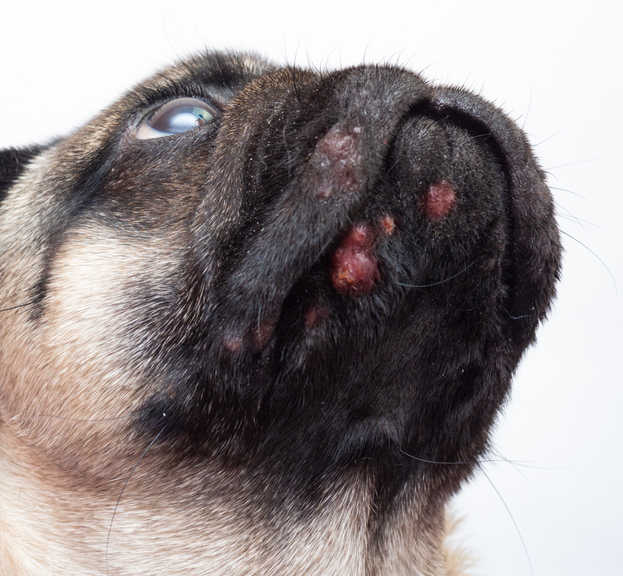
Many dogs with skin acne will have allergic skin diseases and will react to foods and things in their environment, such as grass and dust mites. We can help them by first identifying and avoiding allergens. Additionally, we can treat their skin inflammation and infections with a medicated wash, antibiotics, and anti-inflammatory medicine.
View more Pictures of Dog Acne with treatment information.
2. Papillomas (warts)
Bumps around a dog’s mouth that are fleshy and appear like ‘little brains’ are usually warts. This is especially true in a patient less than two years of age. These are very common and of little concern.
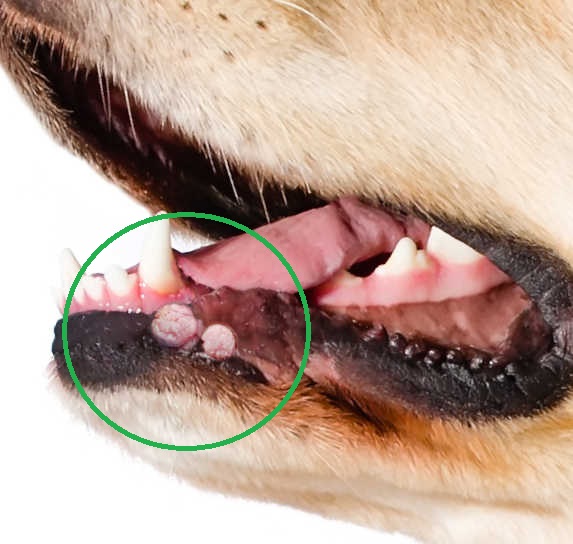
In my clinic, I see warts at least once a week. Thankfully, for the vast majority of dogs, no specific treatment is needed. Their warts will naturally get smaller and go away with time.
Read more about Warts: Pictures, Diagnosis, Treatments.
3. Skin tags
White bumps on a dog’s lips could also be skin tags. These are not associated with the Papillomavirus and are something we see more in elderly dogs. Skin tags on dogs are small, benign growths that hang off the skin, often resembling warts.
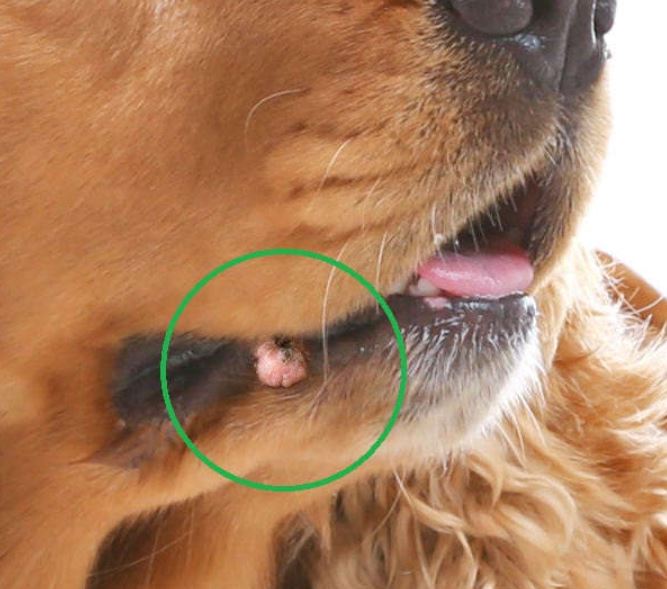
Skin tags are typically harmless but can be removed if causing your dog any irritation.
Read more about Skin Tags: Pictures, Diagnosis, Treatments.
Does your dog have a bump on their lips – but it does not look like the pictures above?
Read our article about Bumps Found on Dog Lips for more information.
Let’s now review lumps and bumps usually found inside the mouth.
Learn more:
Bumps and lumps on a dog’s lips
Learn more about common issues with the mouth:
Mouth cancer & life expectancy
Disclaimer: This website's content is not a substitute for veterinary care. Always consult with your veterinarian for healthcare decisions. Read More.


Be the first to comment